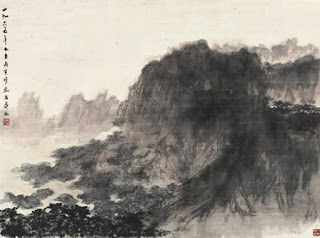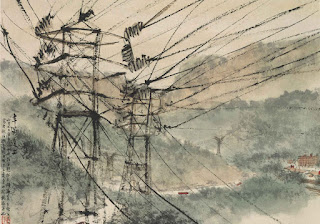Fu Baoshi (Chinese: 傅抱石), or Fu Pao-Shih, (1904-1965) was a Chinese painter from Xinyu, Jiangxi Province. He went to Japan to study the History of Oriental Art in the Tokyo School of Fine Arts in 1933. He translated many books from Japanese and carried out his own research. In painting itself, he brought Japanese visual elements to the Chinese ink painting tradition.
He was the Director of the Jiangsu Province Chinese Painting School and a Vice-Chairman of the Federation of Chinese Artists. He also taught in the Art Department of Central University (now Nanjing University).[1] His works of landscape painting employed skillful use of dots and inking methods, creating a new technique encompassing many varieties within traditional rules. He was able to create an old, elegant style through his integration of poetic atmosphere and painting techniques. He held many personal exhibitions in China and won favourable comments.
Fu had strong feelings towards the land of China. During his travel to many places, he recorded the splendors of the rivers and mountains, drawing inspiration from nature and becoming the representative landscape painter of his time.
Fu wrote numerous fine arts theses, the earliest of which, "On the Evolution of Chinese Paintings", was written at the age of 25. He also carried out in-depth research into the history of landscape painting at the end of the 4th century, including the works of Gu Kaizhi of the Eastern Jin Dynasty (317-420), Zhan Ziqian of the Sui Dynasty (581-618) and Jing Hao of the Five Dynasties Period (907-960), as well as Wu Daozi, Li Sixun, Li Zhaodao and Zhang Yanyuan of the Tang Dynasty (618-907). He worked very hard to imitate paintings by Gao Kegong and Ni Zan of the Yuan Dynasty (1271-1368) Chen Hongshou of the Ming Dynasty (1368-1644), and Cheng Sui, Kun Can, Zha Shibiao, Gong Xian, Mei Qing, Wui Li, Yun Shouping and Shi Tao of the Qing Dynasty (1644-1911), finally becoming one of the master painters of his age. In this capacity he succeeded Huang Binhong, who had created a new style of landscape painting called "Baoshi's texture strokes" basing on the cattle-hair strokes of Wang Meng of the Yuan Dynasty.
As well as painting landscapes, Fu Baoshi was also an accomplished painter of figures. His paintings of ancient Chinese figures from the 3rd and 4th centuries BC are particularly acclaimed.
As a leader of the so-called New Chinese Painting Movement, which reformed traditional Chinese painting after 1949, Fu stood out from most of his contemporaries with his great passion for art, and his innovative brushwork and unique picture composition.
Fu's reforms were followed by a group of artists in Nanjing where he then lived. He was recognized as the founder of the Nanjing-based New Jinling School of Fine Arts. The school included such important artists as Chen Zhifo (1896-1962), Qian Songyan (1898-1985), Song Wenzhi (1919-1999), Wei Zixi (1915-2002) and Ya Ming (1924-2002).
Fu Baoshi was a great admirer of Shi Tao and, at the age of 18, changed his name to "Bao Shi" - meaning embracing "Shitao". He even wrote a chronicle of Shitao, recording his life experiences and social activities as well as his art creations. Fu Baoshi admitted that he was obsessed with the study of Shitao's painting.


















































































No comments:
Post a Comment